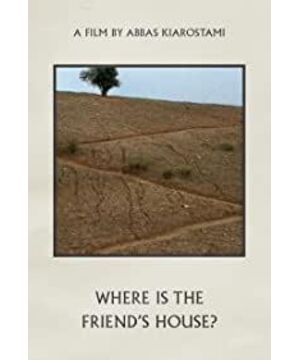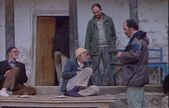——Inscription
Plot
I have only seen two Iranian movies, one is "The Color of Heaven" by Maji McGidi, and the other is "Where Is My Friend's Home" by Abbas. Coincidentally, both are movies about kids. I was deeply shocked by the pure hearts of the two children, and I felt a sense of loss.
The film starts with a classroom, a teacher, a bunch of children. Ahmad's deskmate did not write the homework in the workbook, so he was reprimanded by the teacher. The same table cried sadly, and I believe that Ahmad was also quite frightened. The film unfolds in pursuit of this frightened little mind.
To see what a director wants to show, just looking at the main plot is often not enough. Usually the details of the film can show the profound thoughts of a great director, especially in an Islamic country, especially in a once colonized Islamic country, especially in a country that is incompatible with other Islamic countries in every way - Iran. There are two important details in the film, one is that all adults are tough, and the other is that all adults turn a deaf ear to the children's words. It is this design that separates the world of adults from the world of children. Teachers, mothers, grandmothers, grandpas, blacksmiths, and old carpenters all live according to their own way of life, and they are not worried about little Ahmad or anyone else disrupting their lives, because They don't hear or think about things that don't concern them at all. Everyone repeats and mechanically lives in their own world, and only Ahmad has been worrying about his roommate, without thinking about himself for a moment.
The child's grandfather said that even if he did not make a mistake, he had to find a reason to beat him. A simple sentence, but revealing the coldness of dogma. Ahmad inquired eagerly behind the window-maker, and the window-smith rode on a donkey and walked on his own without looking back. The child ran up and down the hillside with only one tree four times, from day to night. Along the way, people point to the road indifferently, even the kind old carpenter insists on his own direction, no matter whether it is in line with what the child said. He just walked slowly, ignoring the anxiety of the child, and from the words he babbled, it could be seen that he was still living in his own world of wooden windows, ignoring the earth-shaking innovation outside. The child returned home frustrated, but the parents seemed like nothing had happened. The mother brought the food, but she didn't know that the child couldn't swallow because of the heavy worries. The child helped the same desk with the homework and handed it over to the same desk in time. When everyone was worried that the teacher saw the difference in handwriting and cursed the two children, the teacher wrote a big good as if he couldn't see anything. The film comes to an abrupt end. The ending of the film seems unexpected, but it is closely compatible with the theme of the film. All adults live in their own world, and the teacher only pays attention to whether the homework is written in the workbook, and does not care who wrote it.
The pure heart shown by Childlike
Abbas is undoubtedly a success. Although we see that the director has a slight criticism of Islamic dogma, but more is to criticize the misreading of Islam by adults. The two words "halal" are emphasizing purity and returning to nature. Li Zhi, a Chinese Muslim who was hundreds of years before Abbas, also made a profound critique of the adult world. He mentioned in "Children's Heart", "A child with a child's heart is never false and pure, and the original heart of the first thought is also the original heart." Similarly, in Zen Buddhism, there is also this saying of returning to the original heart. We are not going to judge whether it is philosophically correct to return to the original heart. However, by comparing the innocence of a child with the heart of an adult, it can make people, not only philosophically, but also instinctively tend to this kind of "excellent innocence". soul.
nice
The beauty of the Iranian town is everywhere in the film. Wild grass, wild flowers, calves, chickens, this kind of beautiful scenery is out of tune with the stereotypes of adults. However, the most beautiful in the film is not these. The beauty of the soul expressed by Ahmad is more direct to the heart. Seeing children can always make those of us who are adults but still have half a foot out of their innocence to reminisce about their most beautiful childhood. True beauty is just that. It is not to construct an eye-catching picture, but to bring the audience into their own hearts, so that the audience's soul can also add a touch to the soul in the film. When the film becomes a part of one's soul, when the child in the film becomes the realization of his childhood imprint, this correspondence becomes the most beautiful thing in the world.
criticism
The beauty of Ahmad's soul being smeared by Abbas is incredible. However, there are still imperfections in the carving of the film. The degree of Westernization in Iran is surprising to me. When I first saw the teacher wearing a shirt and trousers, I thought it was a classroom in a village in Europe. Iran, which has been occupied by Britain for many years, reveals the European style in every way, including the film itself. Telling a story so slowly is like a European literary film. The director wants to use this innocent innocence to impress those people who are far away in the West who also believe in God, and tell the peace of Islam intentionally or unintentionally. However, this kind of peace, this kind of effort to return to nature, is more like an expression of helplessness. When the process of modernization has swept the entire Islamic world, it is only through the director's painstaking efforts to return to this pure artistic conception. At first glance, everyone saw the precious childlike innocence, but when I looked again, I saw a mixed Iran. The same story can happen in India, it can happen in China, it can happen in a small country in Africa. Even "No One Can Be Missed" has this kind of childlike connotation. I don't see Iranian qualities through the film, I only see a rebellion against dogma and a praising of authenticity. But isn't this repetitive, return to authenticity, a transformation from one dogma to another? Like the children in the film, the film is persistently pursuing an unattainable goal. People are saddened by the failure of the pursuit, but have not thought about it, perhaps the pursuit itself is wrong. The real rebellion against dogma is not returning to a state without dogma, but freedom within dogma. We are far from having to return to the so-called "original mind"-because this is just an extension of the attachment to "self" and the strengthening of self-imprisonment-we can completely face the world calmly and use different methods to regulate ourselves inner, and use different means to achieve outer goals. Just like "Lola Run", it is impossible to return, and it can only be changed through one's own efforts.
View more about Where Is the Friend's House? reviews








